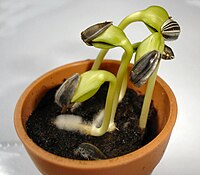
Photo from wikipedia
An improved understanding of seed quality and germination control can contribute effectively to the use and conservation of neglected native species with ecological and economic value, such as Trichocline catharinensis,… Click to show full abstract
An improved understanding of seed quality and germination control can contribute effectively to the use and conservation of neglected native species with ecological and economic value, such as Trichocline catharinensis, an endemic Asteraceae species from southern Brazil. We investigated the effects of applying gibberellin (GA3), abscisic acid (ABA) and their biosynthesis inhibitors, paclobutrazol (PAC) and fluridone (FLU), respectively, on T. catharinensis seed germination, and on polyamine (PA) content and antioxidant enzyme activities in germinating seeds. FLU and GA3 increased seed germination speed compared to treatment with H2O only. ABA inhibited both germination speed index and percentage, while PAC severely inhibited seed germination. The stimulatory effect of GA3 and FLU was associated with increased contents of putrescine (PUT) and spermidine (SPD) relative to spermine (SPM). As a result, high ratio (PUT + SPD/SPM) as well as superoxide dismutase (SOD), catalase (CAT) and ascorbate peroxidase (APX) enzyme activities were observed when seed germination occurs. In contrast, in low or no seed germination treatment (ABA and PAC), low ratio (PUT + SPD/SPM) was observed, while the antioxidant enzymes, mainly SOD activity, tended to increase. Application of PAs at 200 μM stimulated germination through improving the speed and uniformity, and this effect was associated with antioxidant enzyme activity. Our results suggest a relationship between PA and the antioxidant system with the physiological mechanism of seed germination. These results improve the physiological knowledge of seed germination control in Asteraceae and contribute to the biological groundwork for future studies on the use and conservation of native species.
Journal Title: Journal of Plant Growth Regulation
Year Published: 2019
Link to full text (if available)
Share on Social Media: Sign Up to like & get
recommendations!